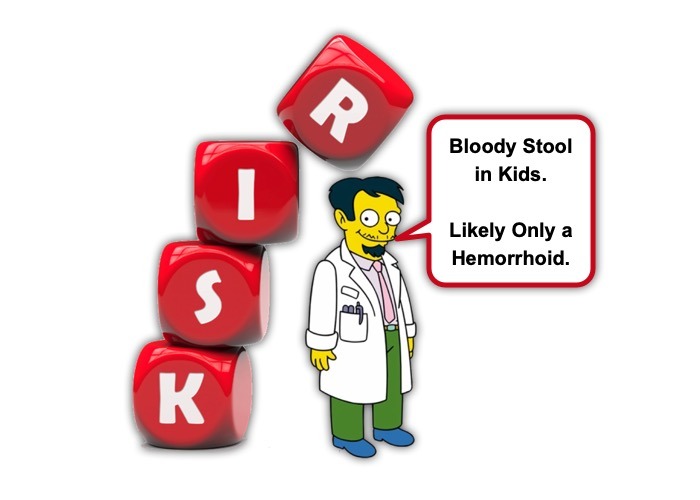Hematochezia in Children

We all know that a common theme of the PedEM Morsels is remaining vigilant in the setting of seemingly benign and subtle (or confusing) presentations because the rare, but deadly entity may be sitting in front of you. Sometimes, however, the presentation is not subtle and, hence, will not be sneaking past us. Hemoptysis, for instance, is going to catch your attention. While the overt symptoms may even be alarming, they do not necessarily make our jobs any easier though. The grotesque complain may be due to a critical illness, but it may also be caused by a benign issue too. A good example of this is bloody stool in children. Let’s take a minute to review Hematochezia in Children:
Hematochezia in Children: Basics
GI Bleeding is a common problem encountered in the Ped ED. [Gultekingil, 2018; Stampfer, 2017]
- Estimated to affect 80-90/100,000 of all Ped ED visits
- 0.5% of hospitalized children
- Fortunately, mortality rate may be low (0.9% in one study -[Gultekingil, 2018])
Wide range of etiologies. [Gultekingil, 2018; Stampfer, 2017]
- Etiologies often vary with age.
- Acute Gastroenteritis is the most common cause of lower GI Bleeding.
- Peptic ulcers and gastritis are also common.
- Esophageal variceal bleeding also can occur.
- Other etiologies include:
- Allergic Colitis
- Inflammatory Bowel Disease
- GI Ischemia
- Coagulopathies
- Meckel’s Diverticulum
- Henoch Schonlein Purpura
- Surgical Complications
Wide range of outcomes. [Gultekingil, 2018]
- Outcomes from self-limited to overt shock.
- Most of Pediatric lower GI Bleeding is self-limited!
- Mallory Weiss tears and Acute Gastroenteritis are associated with self-limited and insignificant bleeding.
- Gastric and Duodenal Ulcers and Gastritis are associated with significant bleeding events.
“Severe bleeding” [Gultekingil, 2018]
- No single clinical finding or laboratory result reliably distinguishes mild cases from more severe bleeding. [Gultekingil, 2018]
- What qualifies as “Severe Bleeding”… good question.
- Gultekingil et al. defined it as GI Bleeding associated with:
- Hemoglobin drop of >/= 2 mg/L
- Need for Blood transfusion
- Need for emergent endoscopy/colonoscopy (within 48 hrs)
Findings associated with “severe bleeding:” [Gultekingil, 2018]
- Presence of melena
- Exam notable for pallor and tachycardia
- Low initial Hemoglobin level (makes sense)
- Elevated BUN level (from increased absorption of blood from GI tract in addition to dehydration)
- Low Albumin level (may be related to malnutrition)
Hematochezia in Children: Causes to Consider
- Infections are the most common cause across all ages. [Bohrer, 2021; Stampfer, 2017]
- Children with hematochezia were found to have 4 times the likelihood of having an infectious pathogens when compared to those with non-bloody diarrhea. [Bohrer, 2021]
- ~2/3rd of cases of hematochezia with diarrhea had an enteropathogen. [Bohrer, 2021]
- Bacteria:
- Salmonella spp.
- STEC (Shiga Toxin Producing E. Coli)
- Shigella spp.
- Campylobacter spp.
- Yersinia spp.
- E. Coli O157:H7
- Viruses:
- Norovirus
- Enteric Adenovirus
- Rotavirus
- Bacteria:
- Testing children with hematochezia for bacterial pathogens can be a reasonable approach. [Bohrer, 2021]
- Antibiotic-Associated Colitis (AAC) was also an important entity.
- Clostridium difficile
- Klebsiella oxytoca [Stampfer, 2017]
- Hematochezia Dx in children in a non-surgical pediatric ward: [Stampfer, 2017; O’Neill, 2016]
- Hematochezia in Infants (< 1 year)
- Food Protein-Induced Proctocolitis (FPIP) accounted for 33.3%.
- Infectious enterocolitis is common also (~35%).
- Hematochezia in Young Children (1-5 years)
- Infectious colitis is most common cause.
- Campylobacter was most common.
- Antibiotic-Associated Colitis also prevalent.
- Infectious colitis is most common cause.
- Hematochezia in Children (6-13 years)
- Infectious colitis accounted for 42%.
- Inflammatory Bowel Disease should be considered (~22%).
- Hematochezia in Adolescents (14-19 years)
- Inflammatory Bowel Diseases prevalent (~20%).
- Infectious colitis still with high prevalence.
- Hematochezia in Infants (< 1 year)
- Other important considerations: [Stampfer, 2017]
- Intussusception
- Midgut Volvulus
- Swallowed Maternal Blood
- Systemic Coagulopathy
- Disseminated Intravascular Coagulation
- Idiopathic Thrombocytopenia Purpura
- Vasculitis
- Polyps
- Fortunately, hematochezia in a non-surgical pediatric patient is not life-threatening in the majority of cases. [Stampfer, 2017]
Moral of the Morsel
- Melena is always a problem! Look for signs if severe bleeding – Melena, Pallor + Tachycardia, Low Hemoglobin, High BUN, Low Albumin.
- Age Matters! It always does. Neonates and infants with bloody stool need different considerations than older children.
- Bugs can cause bloody! Infections in the GI tract are the most common cause of hematochezia across the age groups.

